It was Vicente del Bosque, the former Spain and Real Madrid manager, who once said: “You watch the game, you don’t see Busquets. You watch Busquets, you see the whole game.”
Of course, we all see Busquets when he’s receiving a pass 30 metres from goal with a marker draped on him, before ridding them with a drag back to shift them off balance. What Del Bosque refers to is the 90-minute experience of the lone defensive midfielder, to whom so much of the team’s equilibrium is tied, and whose many acts are almost too subtle to detect in the moment. While the team machine keeps functioning, the pivote can become a hostage to recognition. And when it breaks down, they’re among the first to hear about it.
In current times, this process is fresher in the mind of Martín Zubimendi than anyone else in La Liga.
The 23-year-old, who debuted in 2019 and now has over 100 appearances for Real Sociedad, is the man that, for many, has become an heir of convenience to Sergio Busquets. Month by month, Zubimendi seems to get incrementally better, and with it his name flies by Barcelona’s radar with greater frequency. That the end is in sight for Busquets only strengthens the link between the Catalan side and Zubimendi, whose name gains notoriety at the same time as the Barcelona man edges further into his final chapter.
How the story plays out from here, nobody knows. Even with the anticipated contract extension at Real Sociedad, it will remain an open topic. But true to form, you can bet Zubimendi isn’t spending too much time in a land of hypotheticals. His present is going far too well for that.
In an interview with Mundo Deportivo in 2021, Zubimendi was asked what a good midfielder – in this sense, more so a defensive midfielder – looked like to him. His answer, albeit a short one, said much about his approach to the game.
“You have to have a sufficient humility to devote yourself to the team,” Zubimendi said. “The first thing is the collective – not being individualistic. [It’s] about being constantly helping, whether it’s for the defensive line or your team-mates higher up.”
The caricature of today’s best in class is a player who touches the ball 100 times in a game and completes 95% of his passes, as if the game belongs to them at a leisurely speed – almost without exertion. That might be possible in Europe’s most dominant teams in certain games, but the reality for Zubimendi is different. At this juncture of his career, he isn’t the type of defensive midfielder for whom the game flows through at a constant rhythm over 90 minutes. Not because it can’t, but because his current context doesn’t necessitate it.
In the meantime, enhancing the other parts of his game has been the best thing that could have happened in view of his progression.
Over the last few seasons, the demands on the 23-year-old have seen him transform from a neat mover of the ball to a defensive midfielder who can handle himself on practically every terrain. Zubimendi’s natural sensibility has meshed with a physical transformation and a competitive drive that has made him a pillar of one of Spain’s top sides, and in a team who boast a mean defensive record in spite of their comfort in possession. He is the axis of a team who compete as well as anyone in the country.
In Real Sociedad’s 4-4-2 diamond, Zubimendi’s pivote role is the counterbalance to David Silva as the No. 10. While Silva is the primary link between the midfield and the front two, Zubimendi spends a lot of time performing the inverse action: sustaining the union between the midfield and defence. And in his third season as a starter, he is firmly in pursuit of the tonic that makes a great defensive midfielder: the ability to both read the game at a high level and be highly competitive in individual battles.
When compared against defensive and central midfielders since the start of last season, Zubimendi ranks in the top five players in La Liga for both duel (62%) and aerial duel (71%) win percentage.
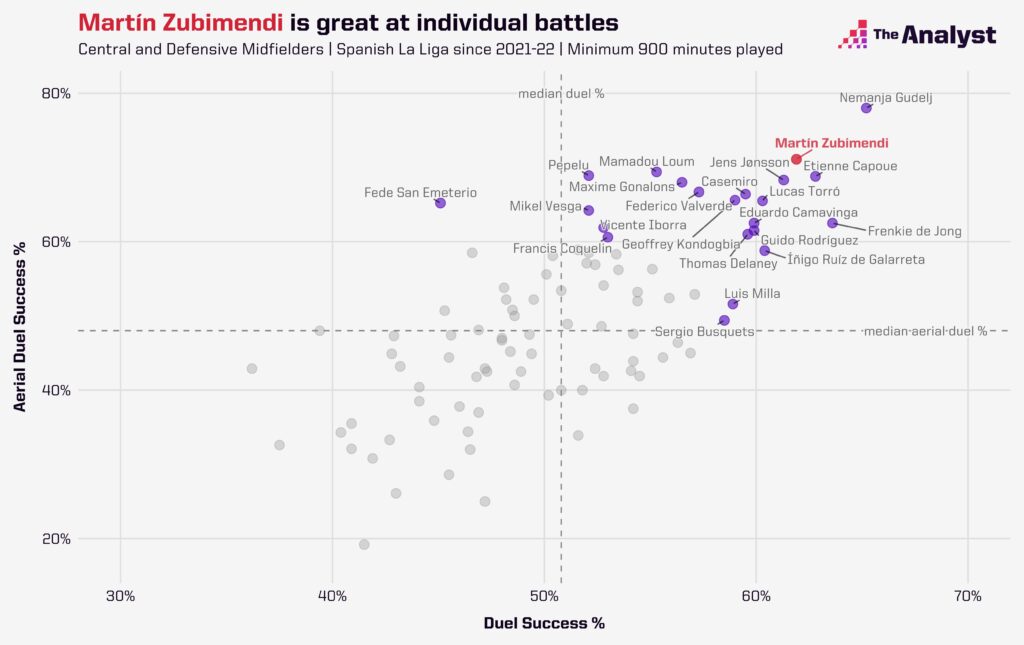
It’s not that the midfielder spends his game dominating his opponent, or rattling through battles in conquering fashion, but something more subtle than that. Zubimendi’s efficiency in his duels is both a product of his physical development and his anticipation – the repeated acts of intervening when necessary, rather than trying to enforce his presence at all times. There is a serenity with which he enacts his defensive contribution; an intelligence that tracks with the lifespan of a midfielder of his type that emerges from Zubieta, the club’s heralded academy. What his century of games at senior level have added is a firmness in his duels, and a surer sense of when to defend with patience and when to step in physically.
This is one of Zubimendi’s persistent challenges at Real Sociedad. In a team who often look to man-mark in midfield – typically in high-pressing situations – he is constantly weighing up the threat level of various situations. When to be tight to his marker and when to lend a hand to the back four is a troubleshooting operation he has become highly refined in judging.
The example below is from a game against Barcelona in August. Although Real Sociedad were closing in on half-time at 1-1, Imanol Alguacil’s side were still looking to be very intense against the away side’s possession. Within this Zubimendi found himself man-marking Pedri, on practically on the same line as forward Alexander Isak, such was the show of aggression. After forcing them back, however, Marc-André ter Stegen would pick out Robert Lewandowski with a zipped pass into the halfway line, which saw Barcelona accelerate an attack on the opposite side of the pitch to Zubimendi.
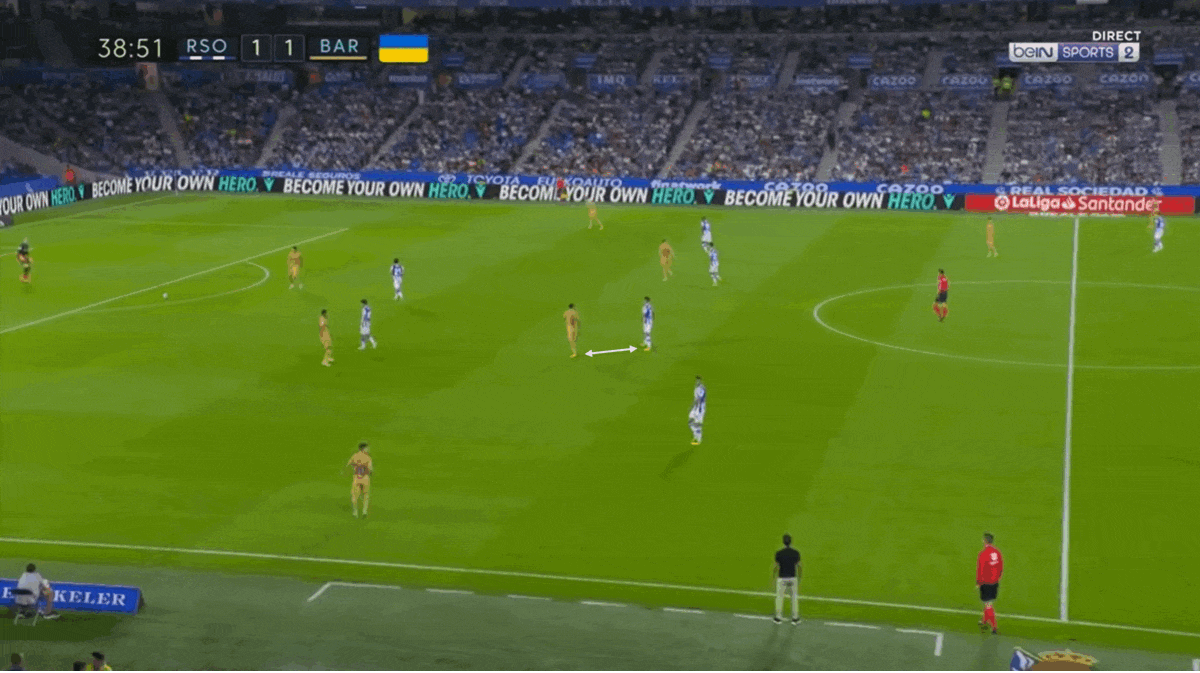
From a move which began with the Real Sociedad midfielder touch-tight to Pedri as a primary receiver, he would end it by reacting quickly to Lewandowski’s flick-on and recovering right to the edge of his penalty area. His presence on the inside would close the door on Ferran Torres – who had driven down the left and begun to cut inside – preventing a dangerous and quick attack from materialising further in the final third. It was a typical show of Zubimendi’s ability to both troubleshoot and defend in a versatile manner, in what was a match typified by break-neck speed attacks.
This brings us to another of his key defensive attributes: protecting the penalty area. One of the primary reasons for Real Sociedad’s defensive excellence in recent seasons has been in how well they shield their box – and in particular, how they recruit midfield help to do so. Since the start of last season in the aforementioned group of defensive and central midfielders, no player has blocked more shots (19) or shots inside the penalty area (15) than Zubimendi in La Liga. He’s also made the fourth-most clearances from inside the penalty area in this period (60), in a team who spend more time with the ball than most.
Though it might sound less significant, and not particularly a trait a team like Barcelona might be wooed by, Zubimendi’s contribution in the pure defensive phase is one that shouldn’t be overlooked. In a Real Sociedad side who are proactive in possession, Zubimendi still figures as one of the most impactful midfielders in Spain in the act of protecting his own box. Through recognition of when and where to be, his concentration in what in an arduous task and his ability to win individual duels, Zubimendi’s service is one that typifies his selfless pursuit of preserving order for La Real.
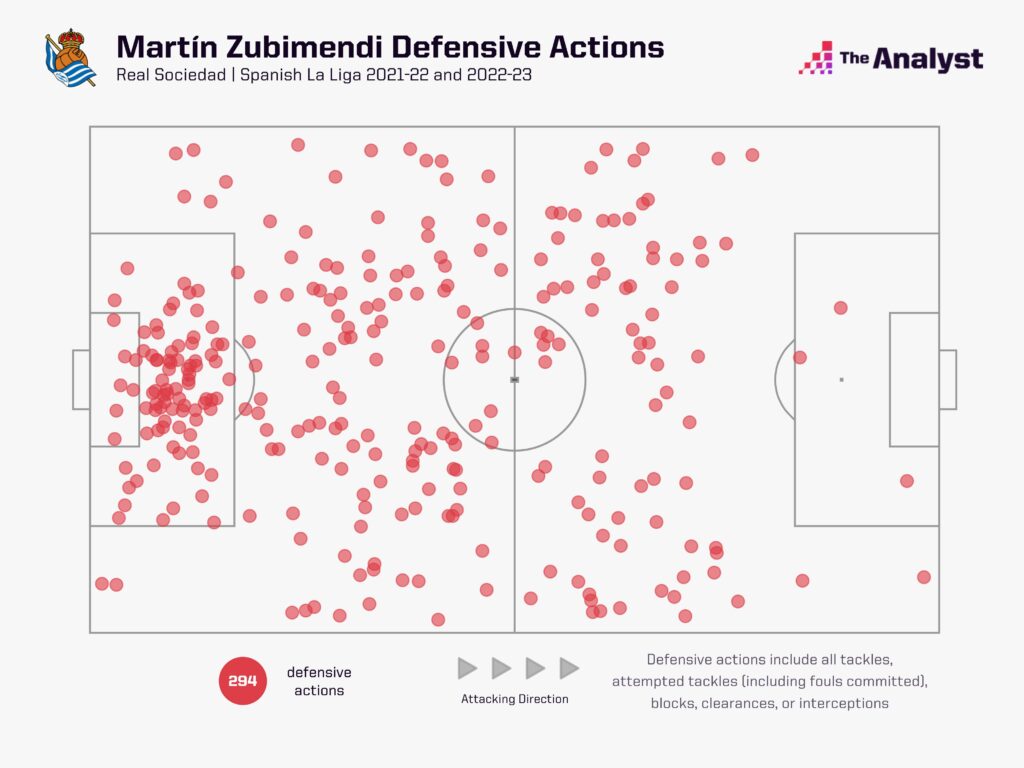
Of course, pivotes in the modern game are always going to be viewed through the lens of what they do with the ball, more so than without it. Being a vigilant defender won’t necessarily take you to the top of the game but combining it with a precision of pass just might.
Before analysing Zubimendi’s work in possession, it’s important to set the context of his current role at club level. Since the back end of last season, Real Sociedad have been using a 4-4-2 diamond system, which is characterised by its abundance of technical midfielders. This setup essentially permits the co-existence of a number of players who might otherwise all want to play in the same No. 10 position, with David Silva, Brais Méndez and Takefusa Kubo all now regularly featuring in the same XI, in distinct roles that don’t restrict their freedom to associate. These players want the ball – and a lot of it too.
“At times, I start to think I’m not doing well when I touch the ball less,” Zubimendi recently told Radio Marca. “Although really I shouldn’t, because I can be the one who is marked and open the gaps and create passing lines for those ahead.”
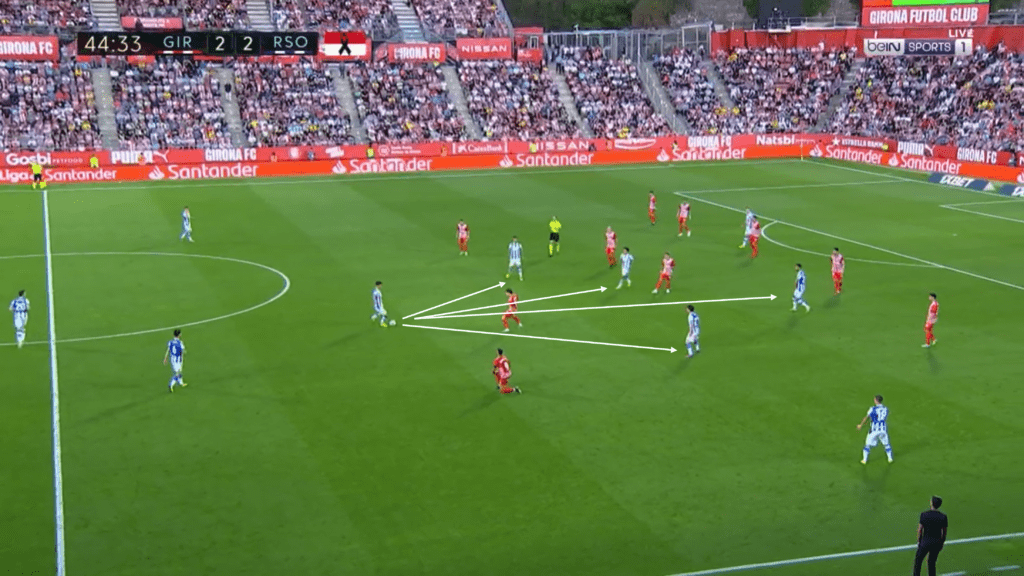
The screenshot above is a frequent sight for La Real since the arrival of the 4-4-2 diamond: Zubimendi at the base of the midfield, with receivers filling the spaces ahead of him just a short pass away. These are the snappy connections that Real Sociedad want, and thus those that their defensive midfielder has to set in motion – as simple a job it might look.
Since the switch to the diamond midfield, La Real’s patience of play has become somewhat of a self-fulfilling prophecy. They move the ball with care because they have a midfield full of technicians whose attributes are best harnessed in this way, and they play like this because their midfielders are their most redeeming asset. Indeed, with Zubimendi as a centrepiece of the operation, Real Sociedad have become one of the most patient passing sides in La Liga in recent seasons – along with Real Madrid and Barcelona, they make up the only three teams to have had 100 sequences of 10+ interrupted passes so far this term.
And it’s not only a means of possession to attack – it’s defending with the ball too.
As the player most often at the base of La Real’s midfield, there’s a lot of responsibility on Zubimendi to both secure the offensive threat ahead of him and sustain the control in midfield. In possession, that means limiting turnovers while circulating the ball and avoiding giveaways that would put the team in a compromised shape. How to balance the team on both sides of the ball is his permanent pursuit – and one which he has learned to blend with greater success by the season.
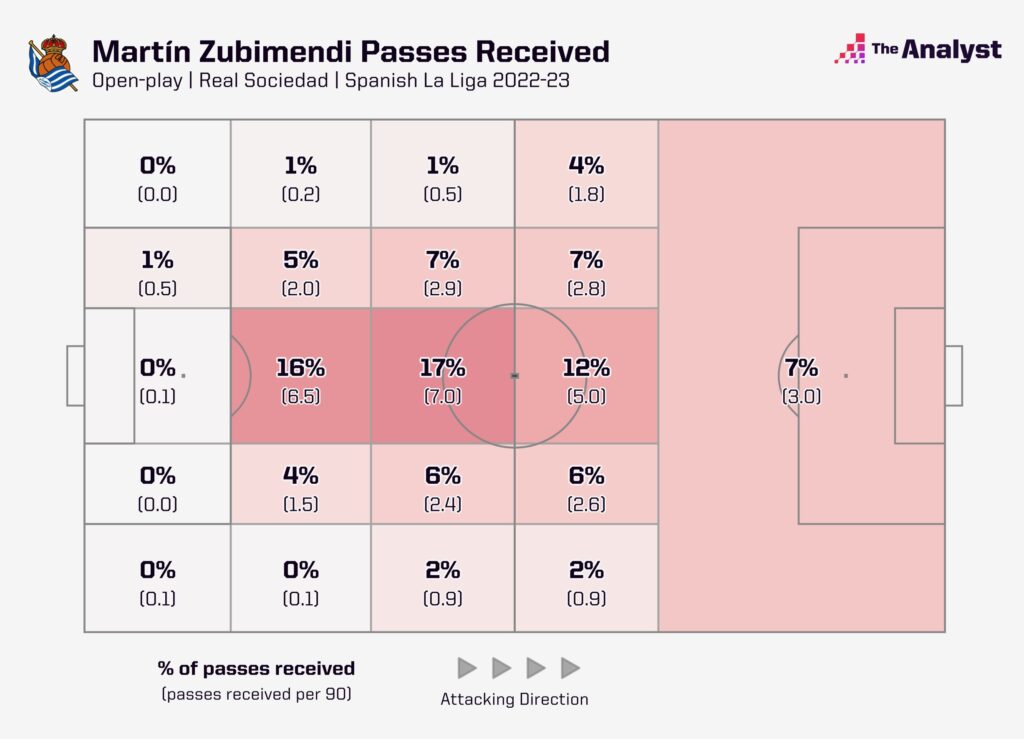
Since the start of last term, Zubimendi has completed 86% of his passes in La Liga, with an average of 51 attempts per 90. In a comparison among defensive and central midfielders in this period, it’s enough to put Zubimendi in the upper-right quadrant – the sweet spot of players who are both above-average in their activity as a passer and in their efficiency in doing so.
The 23-year-old has always been a tidy mover of the ball. That much was clear from his first season. And quite frankly, it’s no surprise for a player who has made it this this far having developed at Zubieta, where his coach in the B team was Xabi Alonso – the man who Zubimendi credits for his understanding of building play from the back. With the passing of the seasons, this education has been thrust against the realities of football at the top level, with lessons learned along the way but reinforced on the other side.
All of which leads us to the present version of Zubimendi: a player moulded in a specific technical form by a thorough education, who has now lived through and understands what it means to apply it in the most competitive scenarios.
After a century of games, he now plays with a composure that isn’t hurried by difficult periods of matches or the quality of opposition. It’s the combination of technical and mental skills to know that the most basic pass might be the best one in the moment, or even, deciding that a movement that doesn’t present him as a receiver of a pass might be more beneficial to the team’s possession. It’s the things that Vicente del Bosque previously referred to – the almost undetectable acts that the pivote leaves on a game.
For Zubimendi, whose trajectory as a player has been ascendant for three consecutive seasons, his next impending development will revolve around the variety of his passing. At the moment, he falls into the ‘sensible’ category rather than ‘determining’ as a distributor, although perhaps that’s tied to the reality of the position. What is clear, however, is that there’s some room for growth in his passing responsibilities – the type that could take him up a further level yet.
In typically attentive fashion, Zubimendi is aware of it and already in the process of diversifying his intentions. Since 2019-20, his first season with notable minutes, the percentage of his passes that are played forward has climbed in each of his four campaigns in La Liga. In the current season, over a third of Zubimendi’s passes are now being played forward (35%); the highest rate of any defensive or central midfielder with at least 500 minutes played.
The sample size for this season is still relatively small, but it’s apparent that Real Sociedad’s midfield diamond is a factor providing fertile ground for Zubimendi’s evolution. With as many as four receivers now playing between the lines – but typically David Silva, Brais Méndez and Takefusa Kubo – there’s a greater onus on the defensive midfielder to pick through the opposition and find service these players. Of course, it’s a strategic intention on the part of La Real, who want to outnumber the opposition in central areas, but it’s also an accelerant of Zubimendi’s passing intent.
The three players that Zubimendi has passed to most often in La Liga this season are Mikel Merino (52), Méndez (40) and Silva (39). Or if you prefer, the other three members of Real Sociedad’s midfield diamond. Although he retains a key role in the team’s build-up and general circulation in deeper areas, there is now a very defined purpose for Zubimendi once out of that first phase of play, that is made possible by this progressive system. Finding players ahead of the ball is now both crucial to La Real’s play and a responsibility that is developing the defensive midfielder’s game.
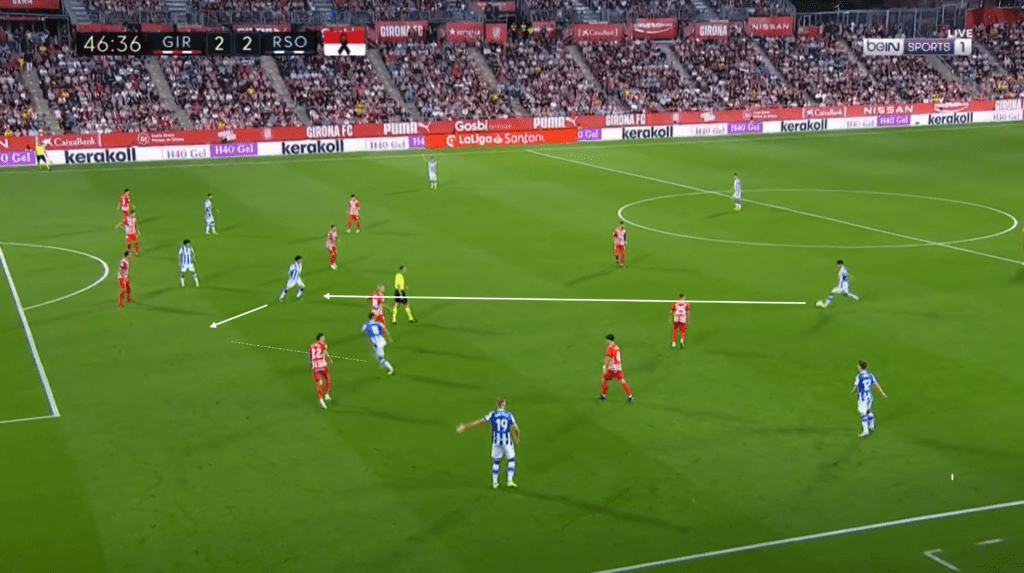
It’s perhaps anecdotal, but Zubimendi has already made more assists this season (two) than he did in La Liga last term (one). Both of those came from forward passes as a midfielder backing up play, with the first being a through-ball for Brais Méndez to finish a one-on-one and the second being a chipped ball over the defence for Alexander Sørloth to finish inside the box. Indeed, although likely to remain low in the long-term, Zubimendi’s expected assists this term (0.54) are almost to that what he managed in 36 league games last season (0.78).
Besides, by the time we’re all said and done, anything remotely tied to direct chance creation would be but a cherry on top of Zubimendi’s game. Sergio Busquets didn’t become one of the greats in his position by making 30 assists in 457 appearances in La Liga. The emblem of assists merely shows the ‘punchier’ nature of Zubimendi’s passing in recent times, and an enhancement being made by a player already embedded at the top of his position in Spain.
While the heir to Sergio Busquets remains an open vacancy, Martín Zubimendi’s name is going to be in the news a lot more than a player of his type typically would be. Even as one of La Liga’s most improved players since 2019, in terms of season-on-season progression, his is a game that doesn’t smack you in the face as soon as you turn on the television. It’s uncomplicated, cerebral, and pursued at every moment with collective benefit over that of the individual.
But just like Vicente del Bosque said, that’s the way it’s meant to look.
Enjoy this? Subscribe to our mailing list to receive exclusive weekly content. And follow us on Twitter too.
